Processing technology of olive oil
Processing technology of olive oil
Olive oil is the oil extracted from the fresh fruit of olive oil by mechanical methods. Generally, the oil is cold-pressed.Extra virgin olive oil (cold-pressed by hydraulic pressure) is the best known, the best quality, no refining, and the most expensive.The more times the screw press is used, the worse the quality will be. The oil and the oil leached from the oil cake must be refined before they can be eaten.Virgin olive oil has a unique aroma and is still liquid at 0°C, so it can be used as cold oil and cooking oil.
The absorption rate of olive oil is 93.4%. It has various health care effects on the human body, especially in reducing cardiovascular disease and promoting the development of children's bones and nervous system.Therefore, olive oil has the reputation of the queen of vegetable oils. In addition, olive oil has a wide range of uses in medicine, beauty, washing, food and other industries.
2.1 Process flow and technical characteristics of olive oil processing
The production process and equipment of olive oil are relatively simple.The traditional method is to first put the ripe and cleaned olive fruit on a stone mill to crush it, then pack it in a clean special straw bag, put it on the oil press to squeeze out the oil, filter, settle and bottle, that is, Can become refined oil. The modern oil production process uses a high-speed centrifuge to quickly separate the oil from the oil, which effectively improves the oil yield and oil quality.
2.2 Modern oil production process
Fresh fruit collection — Transportation and storage — Removal of branches and leaves, cleaning — Crushing — Pressing — Centrifugal decantation — Centrifugal separation — Storage — Bottling.
1. ) Fresh fruit collection
Due to different varieties, the best collection month is from November to February of the following year, and direct contact between the fruit and the ground should be avoided when picking fruit. Green fruit has low oil content but high polyphenolic compounds, and black fruit has high oil content but low antioxidant content. Therefore, in order to ensure oil quality and oil yield, the optimal ratio of green fruit to black fruit is 75:25 , The actual standard production control its ratio of about 50:50.
2. ) Transportation and storage
The collected fresh fruits should be put into small baskets, and the baskets should be stacked, transported to the processing plant, and laid flat in a ventilated storage room to avoid overpressure, overheating and bruising of the fresh fruit, otherwise it is easy to oxidize and ferment. However, in the actual transportation, hemp bags are used for stacking the fruit, so the stacking time does not exceed 1 to 2 days.
3. ) Removal of branches and leaves, cleaning
Using belt conveying and air selection, the branches and leaves are separated from the fruit by the fan. It is required that there are no leaves in the fruit, because the leaves contain more chlorophyll, and in the process of crushing and fusion, the chlorophyll is easily oxidized due to the high temperature and affects the oil quality.
4. ) Cleaning
The purpose is to remove dust and a small amount of leaves. Cleaning requires a certain amount of water, which will produce waste water. In order to reduce the amount of waste water, circulating water can be used for cleaning.
5. ) Crushing
The size of the sieve hole and the beating speed are the key points of the hammer crusher. The optimal sieve hole diameter is 6 million, and the best hammering speed is 2500~3000r/min.The quality of its oil had better results.
6. ) Pressing
The crushed olive pulp is wrapped in filter cloth and put into a hydraulic press for cold pressing. On the one hand, the hydraulic pressure will not generate high temperature to damage the internal structure of the olive, and on the other hand, it is conducive to the formation of oil droplets.A water-oil mixture can be obtained without re-filtration.
7. ) Centrifugal decantation
At present, most of them use three-phase centrifugation, and a few adopt two-phase centrifugation. Three-phase centrifugation needs to add 40% to 50% of water, of which the pomace accounts for about 45%, the residual oil rate is 4% to 6%, and the oil yield is about 25%. About 75%, its water content is 60%-65%, and the oil yield is about 25%. Centrifuge speed is 3000r/min
8. ) Storage
The centrifuged oil is stored in a large stainless steel storage tank to avoid light and heat, and can be filled with nitrogen for protection if necessary.
9. ) Bottling
The oil in the storage tank regularly releases a small amount of water and oil feet. If it is still not clear, it can be mixed with diatomite and filtered through the plate and frame, and then divided into small bottles.








